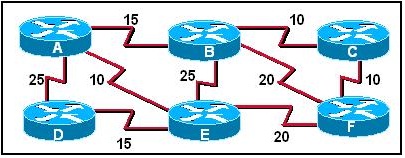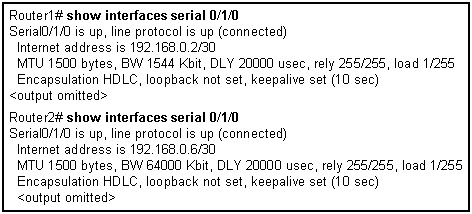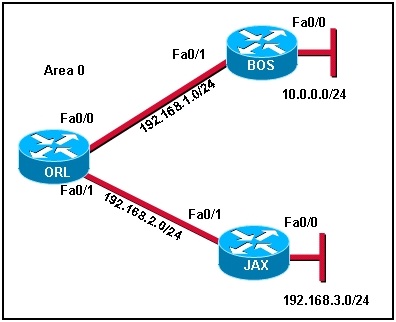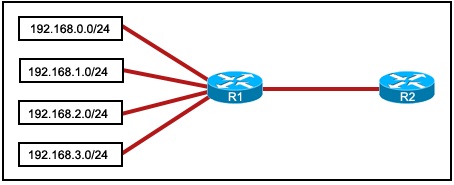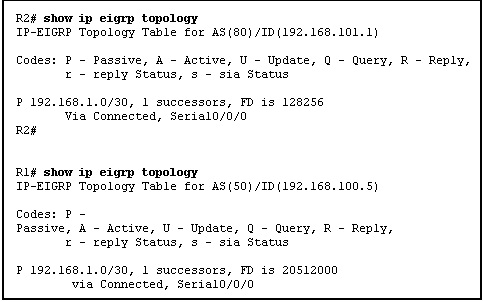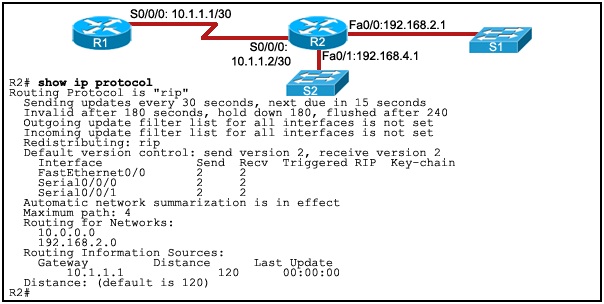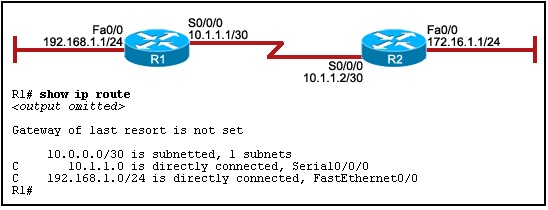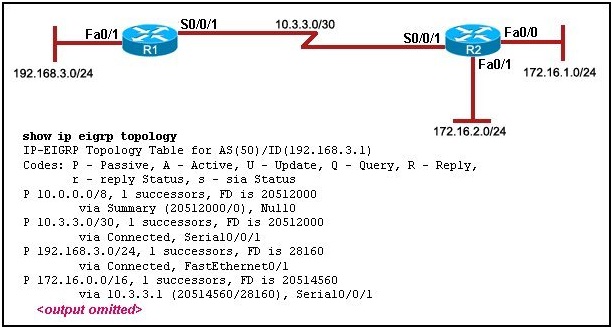CCNA 5.0 (CCNA R&S) – ccna 2 final exam 1 – p1
1 Which of the following are required when adding a network to the OSPF routing process configuration? (Choose three.)
network address
loopback address
autonomous system number
subnet mask
wildcard mask
area ID
2 Which of the following are primary functions of a router? (Choose two.)
packet switching
microsegmentation
domain name resolution
path selection
flow control
3 Refer to the routing table shown in the exhibit. What is the meaning of the highlighted value 192?
It is the value assigned by the Dijkstra algorithm that designates the number of hops in the network.
It is the value used by the DUAL algorithm to determine the bandwidth for the link.
It is the metric, which is cost.
It is the administrative distance.
4 Which three statements are true regarding the encapsulation and de-encapsulation of packets when traveling through a router? (Choose three.)
The router modifies the TTL field, decrementing it by one.
The router changes the source IP to the IP of the exit interface.
The router maintains the same source and destination IP.
The router changes the source physical address to the physical address of the exit interface.
The router changes the destination IP to the IP of the exit interface.
The router sends the packet out all other interfaces, besides the one it entered the router on.
CCNA 5.0 (CCNA R&S) – ccna 2 final exam 1 – p1
5 Refer to the exhibit. Which path will traffic from the 172.16.1.0/24 network take to get to the 10.0.0.0/24 network?
ADC
ABC
It will load balance the traffic between ADC and ABC
It will send the traffic via ABC, and will use ADC as a backup path only when ABC fails.
6 What is the purpose of the TTL field within an IP packet header?
clears an unreachable route from the routing table after the invalid timer expires
prevents regular update messages from inappropriately reinstating a route that may have gone bad
removes an unreachable route from the routing table after the flush timer expires
limits the period of time or number of hops a packet can traverse through the network before it should be discarded
used to mark the route as unreachable in a routing update that is sent to other routers
7 Refer to the exhibit. How many routes are both level 1 and qualify for use as an ultimate route?
1
2
3
4
5
6
8 Refer to the exhibit. Cost for each path are shown. If all routers are configured to use OSPF, what would be the path of a packet sent from Router C to Router D if Router A was down?
C-B-E-D
C-B-A-D
C-F-E-D
C-F-B-A-D
C-F-E-A-D
9 Refer to the exhibit. Routers 1 and 2 are directly connected over a serial link. Pings are failing between the two routers. What change by the administrator will correct the problem?
Set the encapsulation on both routers to PPP.
Decrease the bandwidth on Serial 0/1/0 on router 2 to 1544.
Change the cable that connects the routers to a crossover cable.
Change the IP address on Serial 0/1/0 on router 2 to 192.168.0.1/30.
CCNA 5.0 (CCNA R&S) – ccna 2 final exam 1 – p1
10 Refer to the exhibit. A network administrator is trying to determine why router JAX has no OSPF routes in its routing table. All routers are configured for OSPF area 0. From the JAX router, the administrator is able to ping its connected interfaces and the Fa0/1 interface of the ORL router but no other router interfaces. What is a logical step that the network administrator should take to troubleshoot the problem?
Reboot the routers.
Change the OSPF process ID on all of the routers to 0.
Check to see if the cable is loose between ORL and JAX.
Check to see if CDP packets are passing between the routers.
Use show and debug commands to determine if hellos are propagating.
11
Refer to the exhibit. Which summarization should R1 use to advertise its networks to R2?
192.168.1.0/24
192.168.0.0/24
192.168.0.0/22
192.168.1.0/22
12 A router boots and enters setup mode. What is the reason for this?
The IOS image is corrupt.
Cisco IOS is missing from flash memory.
The configuration file is missing from NVRAM.
The POST process has detected hardware failure.
13
Refer to the exhibit. R1 is configured properly for a single area OSPF, and R2 has been recently installed in the network. Which set of commands is required to configure a single area OSPF for the networks that are connected to R2?
R2(config)# router ospf 1
R2(config-router)# network 192.168.2.0 0.0.0.255 area 0
R2(config-router)# network 10.1.1.0 0.0.0.3 area 0
R2(config)# router ospf 1
R2(config-router)# network 192.168.2.0 0.0.0.255 area 0
R2(config)# router ospf 2
R2(config-router)# network 10.1.1.0 0.0.0.3 area 0
R2(config)# router ospf 1
R2(config-router)# network 192.168.2.0 0.0.0.255 area 0
R2(config-router)# network 10.1.1.0 0.0.0.3 area 1
R2(config)# router ospf 1
R2(config-router)# network 192.168.2.0 0.0.0.255 area 0
R2(config-router)# network 10.0.0.0 0.0.0.3 area 1
14
Refer to the exhibit. Routers R1 and R2 are directly connected via their serial interfaces and are both running the EIGRP routing protocol. R1 and R2 can ping the directly connected serial interface of their neighbor, but they cannot form an EIGRP neighbor adjacency.
What action should be taken to solve this problem?
Enable the serial interfaces of both routers.
Configure EIGRP to send periodic updates.
Configure the same hello interval between the routers.
Configure both routers with the same EIGRP process ID.
CCNA 5.0 (CCNA R&S) – ccna 2 final exam 1 – p1
15
Refer to the exhibit. The hosts that are connected to R2 are unable to ping the hosts that are connected to R1. How can this problem be resolved?
Configure the router ID on both routers.
Configure the R2 router interfaces for area 0.
Configure a loopback interface on both routers.
Configure the proper subnet masks on the router interfaces.
16 In a lab test environment, a router has learned about network 172.16.1.0 through four different dynamic routing processes. Which route will be used to reach this network?
D 172.16.1.0/24 [90/2195456] via 192.168.200.1, 00:00:09, Serial0/0/0
O 172.16.1.0/24 [110/1012] via 192.168.200.1, 00:00:22, Serial0/0/0
R 172.16.1.0/24 [120/1] via 192.168.200.1, 00:00:17, Serial0/0/0
I 172.16.1.0/24 [100/1192] via 192.168.200.1, 00:00:09, Serial0/0/0
17 Which statement is true about the metrics used by routing protocols?
A metric is a value used by a particular routing protocol to compare paths to remote networks.
A common metric is used by all routing protocols.
The metric with the highest value is installed in the routing table.
The router may use only one parameter at a time to calculate the metric.
18
Refer to the exhibit. Both routers are using the RIPv2 routing protocol and static routes are undefined. R1 can ping 192.168.2.1 and 10.1.1.2, but is unable to ping 192.168.4.1.
What is the reason for the ping failure?
The serial interface between two routers is down.
R2 is not forwarding the routing updates.
The 192.168.4.0 network is not included in the RIP configuration of R2.
RIPv1 needs to be configured.
19 Which two statements are true about the EIGRP successor route? (Choose two.)
It is saved in the topology table for use if the primary route fails.
It may be backed up by a feasible successor route.
It is used by EIGRP to forward traffic to the destination.
It is flagged as active in the routing table.
After the discovery process has occurred, the successor route is stored in the neighbor table.
CCNA 5.0 (CCNA R&S) – ccna 2 final exam 1 – p1
20
Refer to the exhibit. Hosts on the 192.168.1.0 network cannot communicate with hosts on the 172.16.1.1 network. The network administrator has run the show ip route command on R1.
What could be the cause of this problem?
The FastEthernet interface on R1 is disabled.
Autosummarization is enabled on R1.
The serial interface S0/0/0 of R1 is administratively down.
No static route or routing protocol is configured.
21 Which statement correctly describes a feature of RIP?
RIP is a link-state routing protocol.
RIP uses only one metric—hop count— for path selection.
Advertised routes with hop counts greater than 10 are unreachable.
Messages are broadcast every 10 seconds.
22
Refer to the exhibit. Which two statements are true based on the exhibited output? (Choose two.)
All routes are stable.
Each route has one feasible successor.
The serial interface between the two routers is down.
The administrative distance of EIGRP has been set to 50.
The show ip eigrp topology command has been run on R1.
23 A network administrator is analyzing routing update behavior on a network that has both EIGRP and OSPF configured on all routers. Both protocols appear in the output of show ip protocols. However, only EIGRP internal routes appear in the routing tables. Which statement correctly explains the scenario?
The OSPF protocol has a higher cost than EIGRP.
The EIGRP protocol has a lower metric than OSPF.
The EIGRP protocol was configured first on the router.
The EIGRP protocol has a lower administrative distance than OSPF.
24 Which prompt is used to allow a user to change the IP address of an interface on a router?
Router>
Router#
Router(config)#
Router(config-if)#
CCNA 5.0 (CCNA R&S) – ccna 2 final exam 1 – p1
25
Refer to the exhibit. Routers RTRA and RTRB are running OSPF. What entry does RTRA add in the routing table when Serial 0/0/0 receives an update about the network that is attached to RTRB?
O 172.16.7.0/30 [110/51] via 10.10.10.2, 00:00:25, Serial0/0/0
O 172.16.7.16/28 [110/51] via 10.10.10.2, 00:00:25, Serial0/0/0
O 172.16.7.0/24 [110/51] via 10.10.10.2, 00:00:25, Serial0/0/0
O 172.16.0.0/16 [110/51] via 10.10.10.2, 00:00:25, Serial0/0/0





